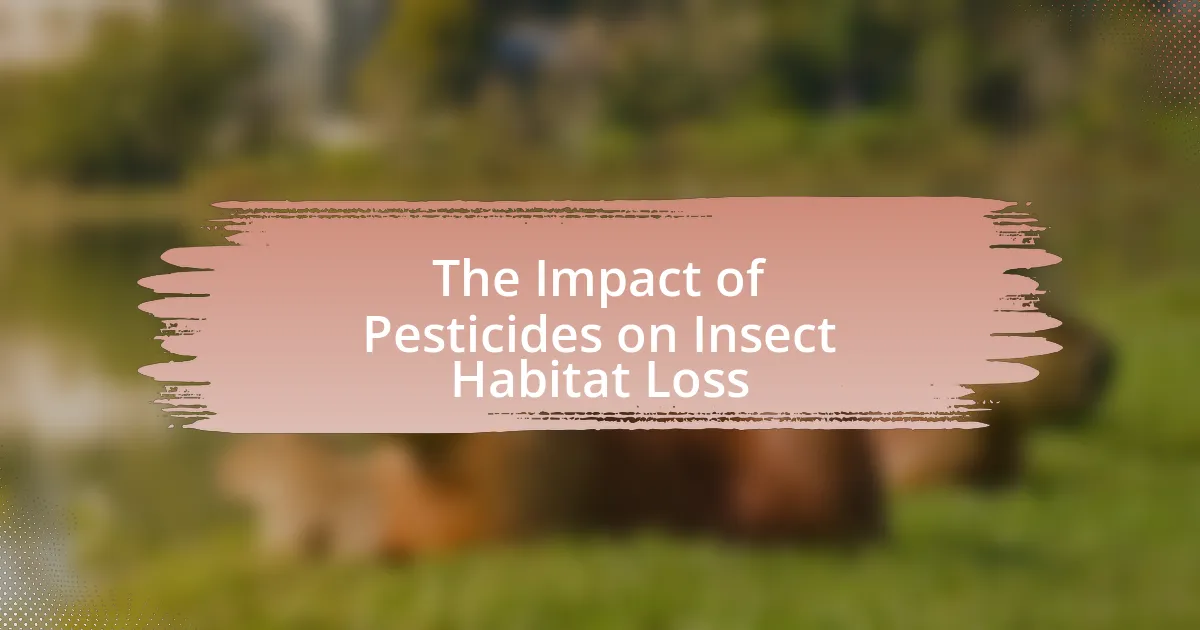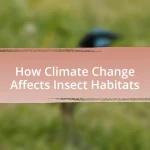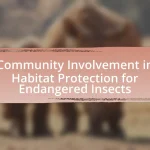The article examines the significant impact of pesticides on insect habitat loss, highlighting how pesticide application degrades ecosystems that support diverse insect populations. It details the detrimental effects of neonicotinoids, a class of pesticides, which can reduce insect populations by up to 50% and disrupt soil health and microbial communities. The article also discusses the critical roles insects play in ecosystems, including pollination and nutrient cycling, and the cascading effects of their decline on biodiversity and food webs. Furthermore, it explores strategies such as integrated pest management and regulatory measures that can mitigate these impacts and support insect habitat preservation.
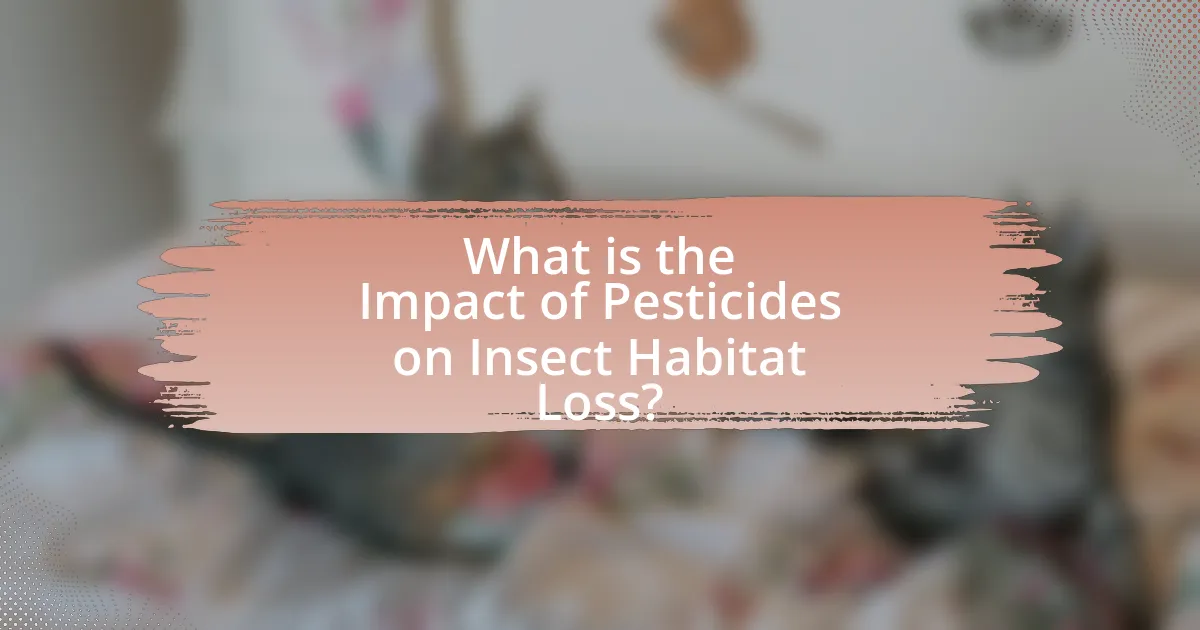
What is the Impact of Pesticides on Insect Habitat Loss?
Pesticides significantly contribute to insect habitat loss by degrading the ecosystems that support diverse insect populations. The application of pesticides leads to the reduction of plant diversity and the destruction of food sources, which are critical for various insect species. For instance, a study published in the journal “Nature” found that neonicotinoids, a class of pesticides, can reduce insect populations by up to 50% in treated areas, directly impacting their habitats. Additionally, pesticides can disrupt the soil microbiome, further diminishing the quality of habitats essential for insects. This loss of habitat not only threatens individual species but also disrupts entire ecosystems, leading to a decline in biodiversity.
How do pesticides affect insect populations?
Pesticides significantly reduce insect populations by causing direct mortality and disrupting reproductive processes. Studies indicate that neonicotinoids, a class of pesticides, can lead to a decline in beneficial insect species, such as pollinators, by impairing their foraging behavior and navigation abilities. For instance, research published in the journal “Nature” found that exposure to neonicotinoids resulted in a 50% reduction in honeybee populations in treated areas compared to control sites. Additionally, pesticides can alter the ecosystem balance, leading to a decrease in biodiversity, as non-target insect species are also affected, further destabilizing food webs.
What types of pesticides are most harmful to insects?
Neonicotinoids are the most harmful types of pesticides to insects. These systemic insecticides affect the central nervous system of insects, leading to paralysis and death. Research has shown that neonicotinoids can significantly reduce insect populations, particularly pollinators like bees, which are crucial for ecosystem health and agriculture. A study published in the journal “Nature” found that neonicotinoid exposure can lead to a decline in bee populations by up to 50%, demonstrating their detrimental impact on insect biodiversity.
How do pesticides disrupt insect life cycles?
Pesticides disrupt insect life cycles primarily by interfering with their reproduction, development, and survival. For instance, insecticides can cause mortality in various life stages, including eggs, larvae, and adults, leading to reduced population numbers. Additionally, pesticides can cause sublethal effects, such as impaired growth and development, which can result in delayed maturation and reduced reproductive success. Research has shown that exposure to neonicotinoids, a class of insecticides, can significantly affect honeybee reproduction and foraging behavior, ultimately impacting their life cycle and colony health. This disruption can lead to population declines and altered community dynamics within ecosystems.
Why is insect habitat loss a concern for ecosystems?
Insect habitat loss is a significant concern for ecosystems because insects play crucial roles in pollination, nutrient cycling, and as a food source for other wildlife. The decline in insect populations due to habitat loss disrupts these essential ecological functions, leading to reduced plant reproduction and biodiversity. For instance, studies indicate that approximately 75% of flowering plants depend on insect pollination, highlighting the direct impact of insect decline on food production and ecosystem stability. Furthermore, the loss of insects can lead to imbalances in food webs, as many species rely on insects for sustenance, which can result in cascading effects throughout the ecosystem.
What roles do insects play in their habitats?
Insects play crucial roles in their habitats, primarily as pollinators, decomposers, and as a food source for other organisms. Pollinators, such as bees and butterflies, facilitate the reproduction of flowering plants, which is essential for ecosystem health and food production; for instance, it is estimated that one-third of the food consumed by humans relies on insect pollination. As decomposers, insects like beetles and ants break down organic matter, recycling nutrients back into the soil, which supports plant growth and maintains soil health. Additionally, insects serve as a vital food source for various animals, including birds, mammals, and amphibians, thereby contributing to the food web and overall biodiversity. These roles underscore the importance of insects in maintaining ecological balance and supporting life in their environments.
How does habitat loss impact biodiversity?
Habitat loss significantly reduces biodiversity by eliminating the natural environments that support various species. When habitats are destroyed or fragmented, many species face extinction due to the loss of food sources, shelter, and breeding grounds. For instance, a study published in the journal “Nature” found that habitat loss is a primary driver of species decline, with approximately 1 million species at risk of extinction, primarily due to human activities such as agriculture and urban development. This decline in biodiversity disrupts ecosystem functions, leading to decreased resilience against environmental changes and loss of ecosystem services.
What are the long-term effects of pesticide use on insect habitats?
The long-term effects of pesticide use on insect habitats include significant declines in insect populations and biodiversity. Research indicates that pesticides can disrupt the reproductive and developmental processes of various insect species, leading to population reductions. For instance, a study published in the journal “Nature” found that neonicotinoids, a class of pesticides, have been linked to a 75% decline in certain pollinator populations over a 27-year period. Additionally, pesticide application can alter habitat structure and availability, further diminishing resources for insects. This disruption not only affects individual species but also destabilizes entire ecosystems, as insects play crucial roles in pollination, nutrient cycling, and food webs.
How do pesticides contribute to the decline of specific insect species?
Pesticides contribute to the decline of specific insect species by causing direct mortality and disrupting reproductive processes. For instance, neonicotinoids, a class of pesticides, have been shown to impair the foraging behavior and navigation of honeybees, leading to reduced colony survival rates. Research published in the journal “Nature” by Goulson et al. (2015) indicates that exposure to these chemicals can result in significant population declines in pollinator species. Additionally, pesticides can alter the ecosystem by reducing the availability of food sources and habitats, further exacerbating the decline of sensitive insect populations.
What are the potential consequences for food webs?
The potential consequences for food webs due to the impact of pesticides on insect habitat loss include decreased biodiversity, disrupted predator-prey relationships, and altered nutrient cycling. When insect populations decline because of pesticide use, the species that rely on these insects for food, such as birds and small mammals, may also experience population declines. For example, studies have shown that a reduction in pollinator populations can lead to decreased plant reproduction, which in turn affects herbivores and the entire food web structure. Additionally, the loss of insects can disrupt the balance of nutrient cycling, as decomposers that rely on insects for organic matter may also decline, further impacting ecosystem health.
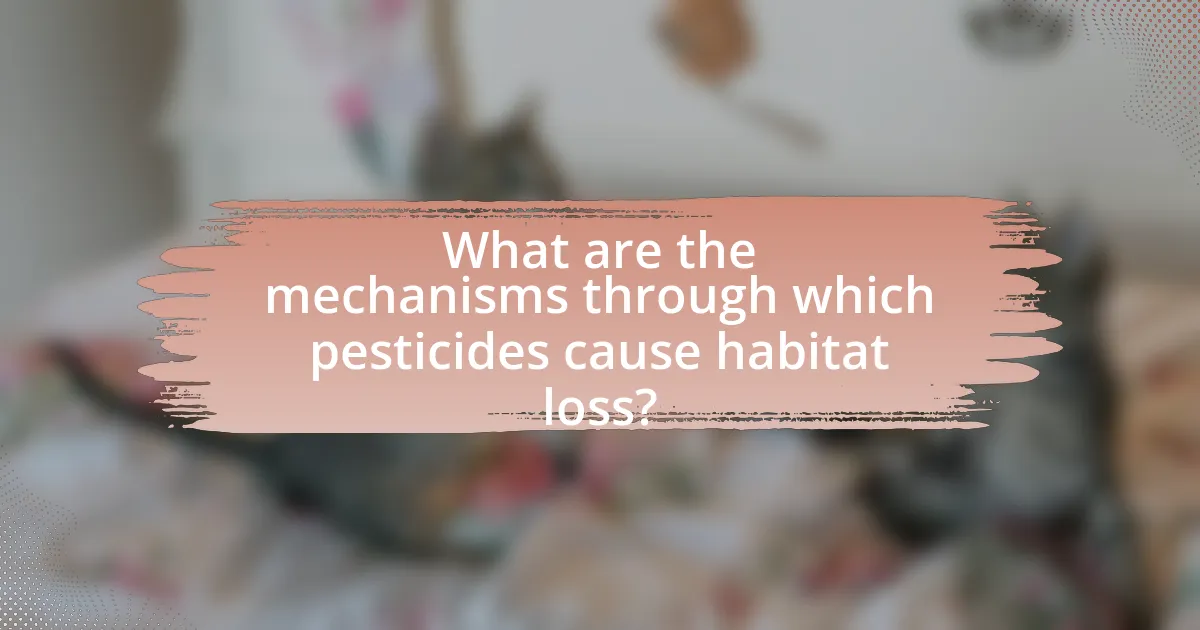
What are the mechanisms through which pesticides cause habitat loss?
Pesticides cause habitat loss primarily through the direct toxicity to non-target organisms, disruption of food webs, and alteration of soil and water quality. The direct toxicity affects beneficial insects, birds, and other wildlife, leading to population declines and reduced biodiversity. For instance, studies have shown that neonicotinoids, a class of pesticides, can significantly reduce bee populations, which are crucial for pollination and ecosystem health. Additionally, pesticides can disrupt food webs by eliminating key species, which in turn affects the species that rely on them for food. Furthermore, the application of pesticides can lead to soil degradation and water contamination, negatively impacting the habitats of various organisms. Research indicates that pesticide runoff can contaminate aquatic ecosystems, leading to habitat loss for aquatic species.
How do pesticides affect soil health?
Pesticides negatively affect soil health by disrupting microbial communities and reducing biodiversity. The application of pesticides can lead to a decline in beneficial soil organisms, such as bacteria and fungi, which are essential for nutrient cycling and soil structure. Research indicates that certain pesticides can decrease microbial biomass by up to 50%, impairing the soil’s ability to support plant growth and maintain ecosystem functions. Additionally, pesticide residues can persist in the soil, further harming non-target organisms and leading to long-term soil degradation.
What is the relationship between soil health and insect habitats?
Soil health directly influences insect habitats by providing essential nutrients, moisture, and structure that support diverse insect populations. Healthy soil fosters a rich ecosystem, promoting plant growth and microbial activity, which in turn creates a suitable environment for insects. Research indicates that soil with high organic matter content supports greater biodiversity, including beneficial insects, as it enhances food availability and habitat complexity. For instance, studies have shown that healthy soils can increase the abundance of pollinators and other beneficial insects, which are crucial for ecosystem balance and agricultural productivity.
How do pesticides alter soil microbial communities?
Pesticides alter soil microbial communities by disrupting the diversity and function of microbial populations. The application of pesticides can lead to a reduction in microbial biomass and diversity, as certain species are more susceptible to chemical exposure than others. For instance, studies have shown that herbicides can significantly decrease the abundance of beneficial bacteria and fungi, which play crucial roles in nutrient cycling and soil health. Research published in the journal “Soil Biology and Biochemistry” indicates that pesticide exposure can shift microbial community composition, favoring resistant species while diminishing sensitive ones, ultimately affecting soil ecosystem functions and resilience.
In what ways do pesticides impact plant-insect interactions?
Pesticides significantly disrupt plant-insect interactions by affecting insect behavior, physiology, and population dynamics. For instance, neonicotinoids, a class of systemic insecticides, impair pollinator foraging behavior and reduce reproductive success in beneficial insects like bees. Research indicates that exposure to these chemicals can lead to decreased pollination efficiency, which directly impacts plant reproduction and biodiversity. Additionally, pesticides can alter the chemical signals plants emit to attract beneficial insects, further disrupting ecological relationships. Studies have shown that the application of pesticides can lead to a decline in insect populations, which in turn affects the plants that rely on these insects for pollination and pest control, creating a cascading effect on ecosystem health.
How do pesticides affect the availability of food sources for insects?
Pesticides significantly reduce the availability of food sources for insects by directly killing beneficial insects and disrupting the ecosystems that support their food supply. For instance, neonicotinoids, a class of widely used pesticides, have been shown to impair the foraging behavior of pollinators like bees, leading to decreased access to flowering plants. Research published in the journal “Nature” indicates that pesticide exposure can lead to a 50% reduction in bee populations, which directly impacts the pollination of crops and wild plants that serve as food for various insect species. Consequently, the decline in these plants diminishes the overall food resources available for insects, further threatening their survival and biodiversity.
What are the implications for pollination services?
The implications for pollination services are significant, as the decline in insect populations due to pesticide use directly affects the availability of pollinators. Pollinators, such as bees and butterflies, are essential for the reproduction of many flowering plants, including crops that humans rely on for food. Research indicates that approximately 75% of global food crops depend on animal pollination, highlighting the critical role of these insects in agricultural productivity. The loss of pollinator habitats, exacerbated by pesticides, leads to reduced pollination efficiency, lower crop yields, and diminished biodiversity. This decline can result in economic losses for farmers and increased food insecurity for populations dependent on these crops.
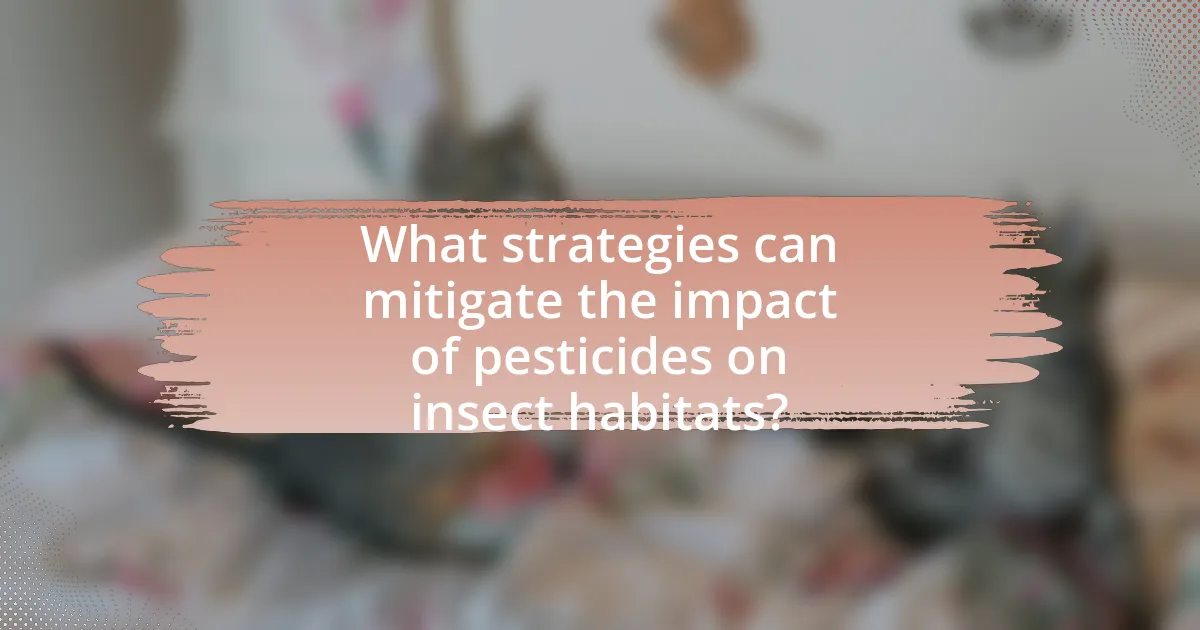
What strategies can mitigate the impact of pesticides on insect habitats?
Implementing integrated pest management (IPM) strategies can significantly mitigate the impact of pesticides on insect habitats. IPM combines biological control, habitat manipulation, and the use of resistant plant varieties to reduce reliance on chemical pesticides. For instance, research indicates that using natural predators and parasitoids can effectively control pest populations while preserving beneficial insect habitats. Additionally, establishing buffer zones with native vegetation can help protect sensitive areas from pesticide drift, thereby maintaining biodiversity. Studies have shown that farms employing IPM practices experience less disruption to insect communities compared to those relying solely on chemical applications.
How can integrated pest management reduce pesticide use?
Integrated pest management (IPM) can reduce pesticide use by employing a combination of biological, cultural, physical, and chemical control methods to manage pest populations effectively. This approach minimizes reliance on chemical pesticides by prioritizing non-chemical strategies, such as introducing natural predators, crop rotation, and habitat manipulation, which can disrupt pest life cycles. Research indicates that farms utilizing IPM practices can reduce pesticide applications by 30% to 50% while maintaining crop yields, demonstrating its effectiveness in sustainable agriculture.
What practices are involved in integrated pest management?
Integrated pest management (IPM) involves a combination of practices aimed at controlling pest populations while minimizing environmental impact. Key practices include monitoring pest populations, using biological control methods such as introducing natural predators, implementing cultural practices like crop rotation and habitat manipulation, and applying chemical controls as a last resort. Research indicates that IPM can reduce pesticide use by 50% or more, thereby mitigating the negative effects of pesticides on insect habitats.
How effective is integrated pest management in protecting insect habitats?
Integrated pest management (IPM) is highly effective in protecting insect habitats by promoting ecological balance and reducing reliance on chemical pesticides. IPM employs a combination of biological, cultural, physical, and chemical tools to manage pest populations while minimizing harm to non-target organisms, including beneficial insects. Research indicates that IPM practices can lead to a significant reduction in pesticide use, which in turn helps preserve insect habitats. For instance, a study published in the journal “Agriculture, Ecosystems & Environment” found that farms implementing IPM strategies experienced a 30% decrease in pesticide applications, resulting in improved biodiversity and healthier ecosystems. This evidence supports the conclusion that IPM is a viable approach for safeguarding insect habitats against the adverse effects of pesticide use.
What role do regulations play in pesticide use and insect conservation?
Regulations play a crucial role in managing pesticide use and promoting insect conservation by establishing guidelines that limit harmful chemical applications. These regulations, such as the Federal Insecticide, Fungicide, and Rodenticide Act (FIFRA) in the United States, require thorough assessments of pesticide safety and environmental impact before approval. By enforcing restrictions on pesticide types, application methods, and usage timing, regulations help mitigate adverse effects on non-target insect populations, including pollinators and beneficial insects. Studies have shown that regions with stricter pesticide regulations experience higher biodiversity and healthier ecosystems, demonstrating the effectiveness of regulatory frameworks in balancing agricultural needs with insect conservation.
How can policy changes support insect habitat preservation?
Policy changes can support insect habitat preservation by implementing stricter regulations on pesticide use, which directly impacts insect populations and their habitats. For instance, the European Union’s 2018 ban on neonicotinoids, a class of pesticides harmful to pollinators, demonstrates how legislative action can lead to improved conditions for insect habitats. Research indicates that reducing pesticide exposure can enhance biodiversity and ecosystem health, as evidenced by studies showing increased insect populations in areas with lower pesticide application. Therefore, effective policy changes can create safer environments for insects, promoting habitat preservation and overall ecological balance.
What are some successful case studies of pesticide regulation?
Successful case studies of pesticide regulation include the European Union’s comprehensive ban on neonicotinoids, which was implemented in 2018 to protect pollinators and biodiversity. This regulation led to a significant reduction in the use of harmful pesticides, resulting in improved bee populations and enhanced ecosystem health. Another example is the United States’ implementation of the Endangered Species Act, which has restricted pesticide use in habitats of threatened species, demonstrating a positive impact on biodiversity conservation. These cases illustrate effective regulatory measures that have successfully mitigated the adverse effects of pesticides on insect habitats.
What practical steps can individuals take to protect insect habitats?
Individuals can protect insect habitats by creating pesticide-free zones in their gardens and yards. By avoiding the use of chemical pesticides, individuals can help maintain the natural ecosystem that supports various insect species. Research indicates that chemical pesticides contribute significantly to habitat loss and decline in insect populations, with studies showing that neonicotinoids, a common class of pesticides, can reduce insect diversity by up to 50% in treated areas. Additionally, individuals can plant native flora, which provides food and shelter for insects, and establish compost areas to promote healthy soil, further supporting insect life.
